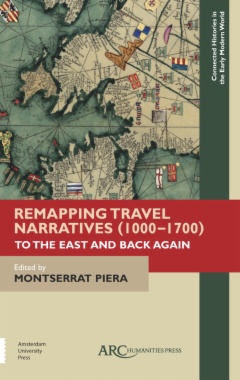With a specific focus on travel narratives, this collection looks at how various Islamic and eastern cultural threads weaved themselves, through travel and trading networks, into Western European/Christian visual culture and discourse and, ultimately, into the artistic explosion which has been labeled the "Renaissance." Scholars from across humanities disciplines examine Islamic, Jewish, Spanish, Italian, and English works from a truly comparative and non-parochial perspective, to explore the transfer through travel of cultural and religious values and artistic and scientific practices, from the eleventh to the seventeenth centuries.
- Front Cover
- Front matter
- Half-title
- About the Series
- Title Page
- Copyright
- Table of Contents
- List of Figures
- List of Contributors
- Acknowledgements
- Body
- Introduction: Travel as episteme—An Introductory Journey
- Part 1. Transforming the rihla Tradition: The Search for Knowledge in Jewish, Muslim, and Christian Travellers
- Chapter 1. From Pious Journeys to the Critique of Sovereignty: Khaqani Shirvani’s Persianate Poetics of Pilgrimage
- Riḥla as a Spiritual Quest
- Persianizing the Riḥla Narrative
- Instructing the Sovereign
- Chapter 2. Observing Ziyara in Two Medieval Muslim Travel Accounts
- Chapter 3. Vulnerable Medieval Iberian Travellers: Benjamin of Tudela’S Sefer Ha- Massa’ot, Pero Tafur’s Andanças ...
- Part 2. Imagining the East: Egypt, Persia, and Istanbul in My Mind
- Chapter 4. “Tierras de Egipto”: Imagined Journeys to the East in the Early Vernacular Literature of Medieval Iberia
- Chapter 5. The Petrification of Rostam: Thomas Herbert’s Re-Vision of Persia in a Relation of Some Yeares Travaile
- The Wonder of a Nation
- Re-vision of Time
- Chapter 6. Between Word and Image: Representations of Shi‘Ite Rituals in the Safavid Empire from Early Modern European ...
- Pietro Della Valle (1586–1652)
- Adam Olearius (1599–1671)
- Jean de Thévenot (1633–1667)
- Conclusion
- Chapter 7. Visions and Transitions of a Pilgrimage of Curiosity: Pietro Della Valle’s Travel to Istanbul (1614–1615)
- A Self-Fashioned Man: Pietro Della Valle’s Life and Travels
- The Road to Istanbul: Troy and the Shared Tradition of Pilgrimage
- The “On-Scene” Witness: Topography of the Ottoman Capital and Urban Projects
- The Go-Between: Translating Ottoman Architecture
- Back to Italy: Collecting and Transmitting
- Acknowledgements
- Part 3. To the East and Back: Exchanging Objects, Ideas, and Texts
- Chapter 8. Gift-Giving in the Carpini Expedition to Mongolia (1246–1248 ce)
- Gift-Giving in Diplomatic Exchange
- Gift-Giving from a Mongol Perspective
- The Purification of Gifts
- The Giver’s Worth
- Refusing Gifts
- Conclusion
- Gift-Giving
- Chapter 9. The East–West Trajectory of Sephardic Sectarianism: From Ibn Daud to Spinoza
- Chapter 10. Piety and Piracy: The Repatriation of the Arm of St. Francis Xavier
- Appendix Barone’s Epigram
- Epigr. CLXIV
- Id. Epigr. CLXV
- Chapter 11. The Other Woman: The Geography of Exclusion in the Knight of Malta (1618)
- Chapter 12. Experiential Knowledge and the Limits of Merchant Credit
- Back matter

